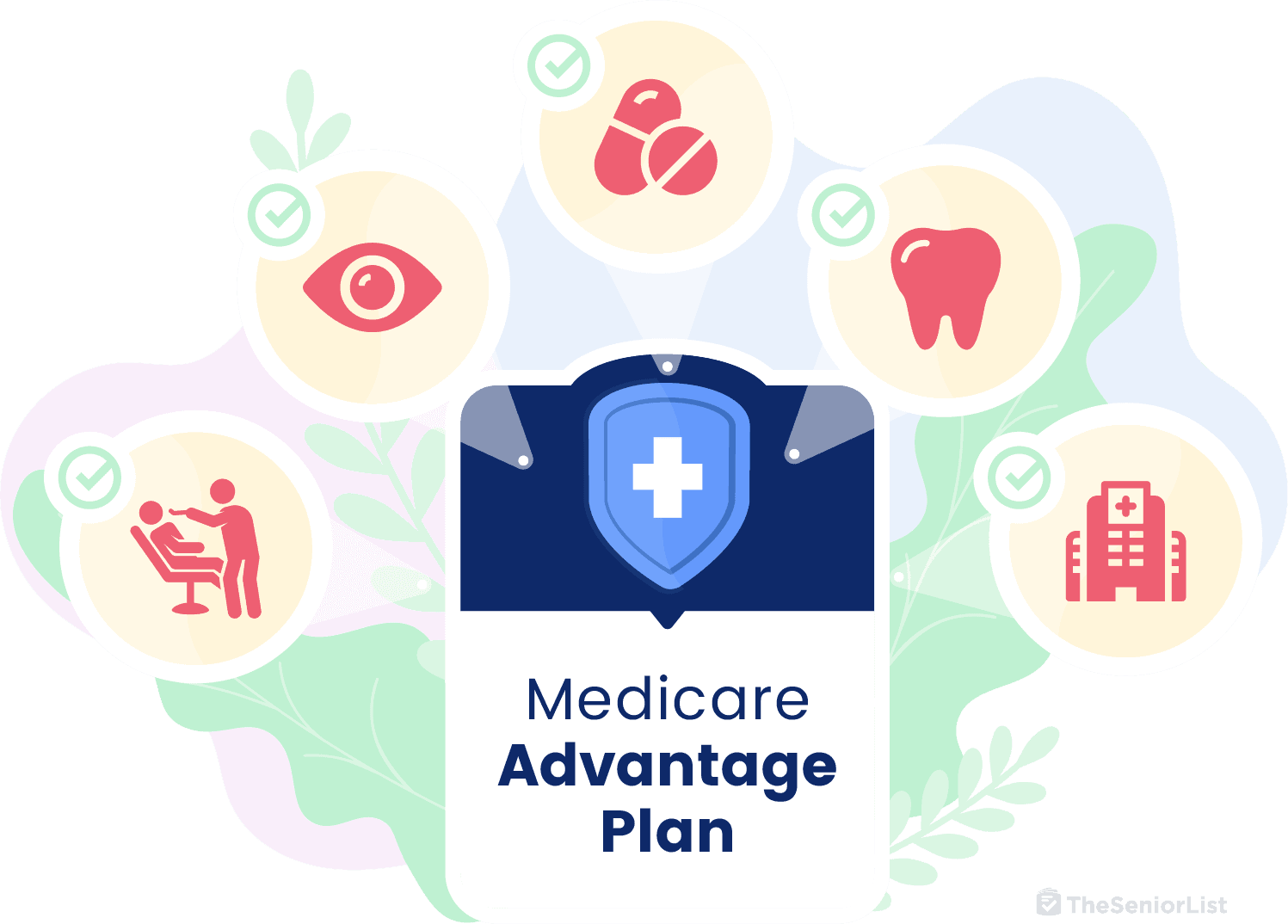What Is Medicare Advantage? A 2025 Guide
An alternative to Original Medicare (Parts A and B), Medicare Advantage provides health insurance to those who qualify for Medicare, often for a low or even no premium. Many of these plans also offer coverage for dental, vision, and hearing needs.
Pro Tip: To learn about our favorite Medicare Advantage providers, check out our guide to this year’s best Medicare Advantage plans.
Pros and Cons of Medicare Advantage
Pros
- Additional benefits: Many Medicare Advantage plans offer savings or subsidies toward hearing, dental, and vision services not covered by Original Medicare.
- Low premiums: In 2025, the average monthly premium for a Medicare Advantage plan is about $20. Numerous Medicare Advantage plans have $0 premiums.
- Out-of-pocket limits: Unlike Original Medicare, for which there’s no annual limit on your out-of-pocket costs, Medicare Advantage plans have a yearly limit on how much you pay for hospital and medical expenses. In 2025, this number is $7,550.
Cons
- Limits on providers: Medicare Advantage is offered through private companies, which means you’re often confined to their networks of providers.
- Geographic constraints: Medicare Advantage plans require you to receive non-emergency medical care in the plan’s service area (generally, in the state in which you reside).
- Inability to switch plans: While it is possible to switch from Medicare Advantage to either Original Medicare or Medigap, the process can be tricky, and you risk incurring late-enrollment fees.
What Is Medicare Part C?
Medicare Part C is another way to refer to Medicare Advantage. To help you learn how this works, check out our one-minute short.
How Medicare Advantage Works
Although Medicare Advantage plans are offered by private companies, they are federally regulated and required to cover everything that Original Medicare covers. Often, Medicare Advantage plans also include Part D (prescription drug) coverage, as well as additional benefits for hearing, vision, or dental.
Often, Medicare Advantage plans have provider networks that restrict where you can obtain health care from. Obtaining care from outside this network may cost you significantly more, or you might not have coverage at all.
Medicare Advantage vs. Medigap
While both Medicare Advantage and Medigap (Medicare Supplement Insurance) are offered by private companies, each serves a slightly different function.
Medicare Advantage plans replace your Original Medicare coverage and potentially offer additional benefits for drug, vision, dental, and hearing coverage.
Medigap plans augment your Original Medicare coverage by covering deductibles, copayments, and coinsurance, among others.
How Much Does Medicare Advantage Cost?
In 2023, the national average monthly premium for a Medicare Advantage plan is about $20. Some premiums are $0, whereas others can be over $100. Additionally, out-of-pocket costs max out at $7,550 for plans that don’t include prescription drug coverage.
It’s important to note, however, that even when you’re enrolled in Medicare Advantage, you’ll still have to pay a premium for Medicare Part B.
Six Types of Medicare Advantage Plans
Health Maintenance Organization (HMO)
HMO plans cover services by providers that are in-network and usually have more plan types than others. If you want to receive out-of-network care, expect to pay the entire bill. It’s important to note that this type of plan limits which doctors/specialists you can see. Out-of-pocket costs are usually lower than they are with PPO plans.
Preferred Provider Organization (PPO)
If you choose a PPO plan, you won’t pay as much when seeing an in-network provider compared to one that is out of network. On average, out-of-pocket costs will be $5,873 for local PPOs and $6,707 for regional PPOs. Take into consideration that PPO plans can now charge an annual deductible for medical and drug coverage, even though most don’t.
Private Fee-for-Service (PFFS)
While not extremely common, PFFS plans may sometimes be network based and require non-network providers to accept Medicare reimbursement along with the plan’s terms and conditions. Additionally, many PFFS plans don’t include prescription drug coverage.
Special Needs Plan (SNP)
SNPs are a type of Medicare Advantage plan. If you have a chronic condition, qualify for both Medicare and Medicaid, or live in an institution like a nursing home, these plans are a great option because benefits, provider choices, and drug formularies are tailored to you. The type of SNP you choose will determine if out-of-network services are covered.
HMO Point-of-Service (HMO POS)
HMO POS plans are a hybrid plan where you can go outside your network for treatment; however, you’ll pay more. Moreover, there are separate deductibles for in- and out-of-network charges.
How to Choose a Medicare Advantage Plan
Before choosing a Medicare Advantage plan, the first thing you should consider are your health needs. Another major determinant is whether you prefer to see doctors/specialists in- or out-of-network. With that comes out-of-pocket costs. Typically, in-network will be cheaper, especially if your plan doesn’t cover out-of-network office visits.
When choosing a plan, ask yourself these questions: Can I continue to see my current doctor? What is the monthly cost? Does it cover prescription drugs? Does it suit my lifestyle/healthcare needs?
>> Related Reading: Is Medicare Advantage a Scam?
Our Favorite Medicare Advantage Providers
Our favorite Medicare Advantage providers offer comprehensive coverage with benefits not found with Original Medicare. Some of these Medicare Advantage plans have $0 premiums:
How to Enroll in Medicare Advantage
If you’re having trouble determining which Medicare Advantages plans are offered near you, use Medicare.gov’s search tool. Once you’ve chosen a plan, you can enroll online or via phone. Keep in mind that enrollment periods (Initial, Open, and Medicare Advantage Open) are crucial, especially if you’re switching.
Switching Medicare Advantage Plans
Switching Medicare Advantage plans is easy, but note that once you do, you can switch to Original Medicare only. If you want to switch to Medigap, there are a few elements to consider:
- Policies don’t cover everything (i.e., long-term care, vision/dental, hearing aids, eyeglasses).
- You need to have both Medicare Part A and B.
- Medigap enhances your Original Medicare benefits only.
- Monthly premiums are required in addition to Part B monthly premiums.
- Medigap covers only one individual.
- Medigap can be purchased only from an insurance company that’s licensed in your place of residence.
- All standardized Medigap policies are guaranteed renewable.
>> Related Reading: Medicare Helpline: Beware of Misleading Advertising
Frequently Asked Questions
-
What are the disadvantages of Medicare Advantage plans?
The primary disadvantage of Medicare Advantage plans is the network restrictions. Unlike Original Medicare, which is widely accepted across the country, Medicare Advantage plans will restrict where you can receive care.
-
Which Medicare Advantage plan has the best dental coverage?
There are a few Medicare Advantage plans that have the best dental coverage, but it depends on certain elements.
- UnitedHealthcare has the largest network size for dental care.
- Cigna and Aetna have the most comprehensive coverage.
- Kaiser Permanente has the highest member satisfaction.
- Humana has the lowest-cost plans.
-
Why are some Medicare Advantage plans free?
No Medicare Advantage plan is free; however, some offer a $0 monthly premium. You’re still required to pay the Medicare Part B premium and cost-sharing. Many providers offer a low or no monthly premium because Medicare pays the private company to take on risk.
-
Can people with preexisting conditions get Medicare Advantage plans?
Yes. If you have a preexisting condition, you can receive Medicare Advantage.
-
Why do doctors not like Medicare Advantage plans?
Many physicians don’t like Medicare Advantage plans because the patient’s financial risk is placed on them. Doctors make a profit only if they stay under budget. If they don’t, they lose money, and you may not receive the appropriate care.






